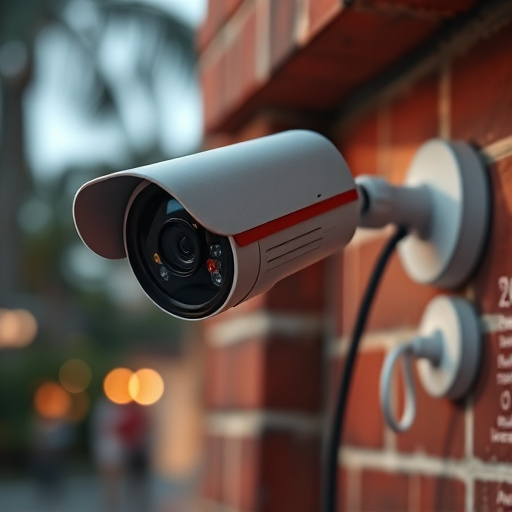Mounting fake security cameras requires considering power sources: batteries for flexibility or AC adapters for reliability. Battery-powered options are ideal for outdoor, temporary setups while hardwired cameras suit permanent installations. Indoor mounting considers outlet access and surge protection. Wireless charging offers a sleek alternative, enhancing aesthetic appeal. Optimizing placement, whether in open areas or hidden corners, ensures effective security with the right power solution for your fake security cameras.
Mounting fake security cameras, also known as dummy cameras, is a popular way to enhance home or business security without the cost and hassle of real surveillance. Understanding the power options available for these devices can help you choose the best solution for your needs. This article explores various dummy camera power sources, including battery-powered solutions, AC adapters, and emerging wireless charging technologies, guiding you through how to mount fake security cameras effectively while ensuring optimal performance and peace of mind.
- Understanding Fake Security Camera Requirements
- Power Sources for Dummy Cameras: Options and Benefits
- Battery-Powered Solutions: A Popular Choice
- AC Adaptation: Pros and Cons for Indoor Use
- Wireless Charging: The Future of Dummy Security Cameras?
Understanding Fake Security Camera Requirements
When considering how to mount fake security cameras, understanding their unique power requirements is essential for a seamless installation. Unlike traditional surveillance equipment, dummy cameras often operate on battery or USB power, making them versatile and convenient for various settings. This flexibility allows you to place these cameras in hard-to-reach areas without the need for complex wiring.
To ensure optimal performance, it’s crucial to select batteries suitable for the camera’s current draw. Most fake security cameras have low power consumption, making standard AA or lithium ion batteries ideal. When mounting, consider placing the camera near a power outlet for easy access and less reliance on battery life. This is particularly important if you plan on leaving the camera active for extended periods.
Power Sources for Dummy Cameras: Options and Benefits
When it comes to powering your dummy security cameras, there are several options available depending on your specific needs and how you plan to mount fake security cameras. The most common power sources include:
1. Battery-Powered: These cameras run on rechargeable batteries, making them ideal for temporary installations or locations without access to a power outlet. You can easily replace or recharge the batteries as needed, ensuring continuous surveillance. This option is also beneficial for how to mount fake security cameras in hard-to-reach areas or during events where you need portable security measures.
2. Hardwired: For permanent or semi-permanent installations, hardwired dummy cameras offer a reliable power supply. They connect directly to your home or business’s electrical system, eliminating the need for frequent battery replacements. This option provides consistent power and is generally more secure, as it requires physical access to disconnect the camera.
Battery-Powered Solutions: A Popular Choice
Battery-powered security cameras are a popular choice for those looking to install dummy or fake security cameras, especially in outdoor locations. This option offers several advantages when it comes to mounting and placement. Without the need for an electrical outlet nearby, battery-powered cameras provide flexibility in terms of where you can strategically place them. You can mount these cameras on walls, fences, trees, or any other surface, making them ideal for both residential and commercial use.
When selecting a battery-powered security camera, consider factors such as battery life, water resistance, and motion detection capabilities. Long-lasting batteries ensure continuous surveillance without frequent replacements. Water resistance is crucial if you’re placing the camera outdoors, as it protects against harsh weather conditions. Motion detection sensors also enhance its effectiveness by triggering alerts when potential intruders are detected.
AC Adaptation: Pros and Cons for Indoor Use
When considering how to mount fake security cameras, one of the primary power options to explore is AC adaptation. This method involves plugging the camera into a standard electrical outlet, offering several advantages for indoor use. Pros include convenience, as it eliminates the need for constant battery replacements or charging, and reliability, ensuring consistent power supply without interruption. This is particularly useful for strategic placements where cameras are out of reach for manual battery changes.
However, AC adaptation also has drawbacks. It requires access to a nearby electrical outlet, which might not always be feasible in all indoor spaces, especially during installation. Additionally, it introduces the risk of power surges or fluctuations affecting camera performance and longevity. For optimal results with fake security cameras, careful consideration of these factors is essential when planning their indoor mounting locations.
Wireless Charging: The Future of Dummy Security Cameras?
Wireless charging is emerging as a potential game-changer in the world of dummy security cameras, offering a convenient and innovative power solution for those looking to mount fake security cameras discreetly. Traditional wired connections can be unsightly and cumbersome, especially when installing hidden cameras. With wireless charging technology, you can say goodbye to tangled wires and unsightly cords, making it an attractive option for how to mount fake security cameras without compromising aesthetics.
This cutting-edge feature allows security camera manufacturers to design sleek and modern dummy cameras that seamlessly blend into their surroundings. By eliminating the need for visible power cables, wireless charging opens up new possibilities for creative mounting strategies. Whether you’re looking to install a fake security camera in a tight space or want to achieve a more aesthetically pleasing setup, wireless charging could be the future of this industry, providing a simple and efficient way to keep an eye on your property without compromising style.
When considering how to mount fake security cameras, understanding your power options is key. From battery-powered solutions to AC adaptation and even wireless charging, each method offers unique benefits tailored to specific needs. By evaluating the pros and cons of each power source, you can make an informed decision that aligns with your desired placement and performance requirements, ensuring optimal protection for your property.
